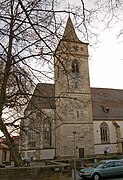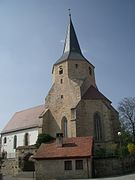Land chapter Grüningen



The Landkapitel Grüningen (also: Ruralkapitel Grüningen or Archidiakonatssprengel Grüningen ) in the Franconian part of the Glemsgau was a pre-Reformation administrative unit of the Archidiaconate Trinity in the Diocese of Speyer . It had its seat in the former imperial city Grüningen (today Markgröningen ).
Historical geography
The land chapter, presumably established in the 11th century, was located in the southeast corner of the Speyer diocese (see map). The originally Franconian diocese had taken over the 496 fixed Franconian-Alemannic demarcation line for its southern demarcation , which swiveled to the northeast from the Hornisgrinde near Maichingen and followed the Glems northwards from Eltingen , swiveled back to the east south of Grüningen and passed Asperg to the south led to Lemberg . In the case of Leonberg, which was founded later, the border evidently diverged briefly from the course of the Glems for strategic reasons in order to include the Engelberg east of the Glemstal as well as the Asperg and Lemberg for border security in the Franconian sphere of influence.
This “mark” to the diocese of Constance was held on until the Reformation , although it divided the ruling district of Glemsgau, established around 750 by the Carolingian house master Karlmann , and the fertile cultural landscape of the Strohgau in two. As a result of this separation, Ditzingen, located on both sides of the Glems, had a Speyr church and a Konstanz church.
hierarchy
Superordinate bodies
The diocese of Speyer was divided into four archdeaconates , which in turn were divided into three to five regional chapters. The rural chapter of Grüningen, together with the rural chapter of Weil der Stadt and the rural chapter of Vaihingen, belonged to the Archdeaconate of Trinity , which was reserved for the “ Provost of All Saints ”. This monastery in Speyer is said to have been founded by Bishop Sigebodo (in office from 1038 to 1051) and had its seat in the early Romanesque collegiate church, which stood not far from the cathedral on the southern city wall .
Land chapter as middle level
The spiritual center of the country chapter was the double-towered Bartholomäuskirche in Grüningen: an early Gothic basilica that was built in the 13th century by Counts Hartmann II and Hartmann III. von Grüningen was rebuilt in place of a Romanesque basilica and expanded in the 15th century with a large choir and a sacristy. In addition to their size, extensive choir stalls testify to their former importance. Its leading pastor and dean Reinhard Gaißer was one of the leading clergy in the Duchy of Württemberg in the 16th century. When Gaisser stood in front of the rebels in the uprising of Poor Konrad (1514), in the ensuing dispute with Vogt Philipp Volland and the ducal court chancellery he received backing from Bishop Georg von der Pfalz , who ignored the appeals to lift Gaisser's immunity.
Subordinate institutions
The parishes , branch churches and chapels in Asperg , Beisheim ( desert near Leonberg ), Ditzingen , Dulcheshausen (desert near Leonberg), Eglosheim , Eltingen , Gebersheim , Grüningen , Heimerdingen , Hemmingen , Hirschlanden , Hochdorf , Höfingen , Rutesheim , Schöckingen belonged to the rural chapter Grüningen , Talhausen , Tamm and in the city of Leonberg, founded in 1248. From when Schwieberdingen, located to the right of the Glems, was part of the Grüningen district is just as unclear as the classification of the Vöhingen desert east of Schwieberdingen, which is closely linked to Grüningen . In the late Middle Ages the Grüninger Heilig-Geist-Spital acquired branch churches in Mühlhausen an der Enz (Landkapitel Pforzheim) as well as in Remmigheim , Bissingen and Bietigheim , which belonged to the Landkapitel Vaihingen.
The Grüninger parish included not only "people priests " and vicars around twelve chaplains , who not only looked after the numerous altars in the Bartholomäuskirche, but also worship services in surrounding churches and chapels such as in Bietigheim, Tamm , Vöhingen , Talhausen and in Sankt-Johanns -Chapel near the Schluesselburg and in the chapel of the former imperial castle.
Special position of the hospital
The Grüninger Heilig-Geist-Spital of the Order of the Holy Spirit in Saxony in Rome occupied a special position , which was not accountable to the Bishop of Speyer, but only to the superior order master of the Alsatian monastery Stephansfeld or the Grand Master in Rome. Notwithstanding this, in addition to the Grand Master in Rome, the Speyer bishop Friedrich von Bolanden also promised 40 days indulgence in 1301 to all patrons who supported the completion of the hospital church . The extensive privileges of the hospital enabled the mobile friars to preach everywhere and with priority, to make the sacrifice, to hear confession and to give indulgence, as well as to beg unhindered in the eastern part of the diocese of Speyer, but also in large parts of the diocese of Constance. With its high income at times, the Grüninger Spital had also gained access to churches: in addition to the Mühlhausen church outside the archdeaconate, the hospital also included the Peterskirche in Bietigheim, the Bissinger Kilianskirche and the Remmigheimer Jakobskirche in the Vaihingen district.
Spiritual tussle
The dispute over the spiritual hierarchy that broke out between Dean Reinhard Gaißer and hospital master Johannes Betz in 1521 was decided by Speyr's Bishop Georg von der Pfalz in favor of Gaisser. He assessed the position of the dean, who was also the “church lord of the land chapter”, as one of the highest ecclesiastical ranks in the Duchy of Württemberg, because the hospital master ranked ahead of the provost of the Stuttgart collegiate church .
resolution
In the late Middle Ages, the land chapter was divided into the Grüningen and Leonberg deaneries . After the Reformation was finally implemented in the duchy, the Speyr diocese had to give up its districts in Württemberg. The land chapter was dissolved and Grüningen was the seat of a special evangelical superintendent , whose district changed several times, especially after the founding of Ludwigsburg (see map from 1736) and was finally incorporated into the Ludwigsburg district in 1812.
Leonberg town church from Engelberg
Laurentius Church in Hemmingen
George's Church in Schwieberdingen
swell
- Diocesan map of the Speier diocese at the end of the Middle Ages . Designed by Franz Xaver Glasschröder , Speyer 1906 (scale 1: 250,000)
- Regesta Imperii (RI online)
- Württemberg Document Book (WUB online)
literature
- Hans Ammerich : The Diocese of Speyer and its history , Volume 1: From the beginnings to the end of the Salier period (1125) ; Kehl am Rhein 1998; ISBN 3-927095-36-2 .
- Gustav Bossert: Württemberg from the Codex Laureshamensis , the Traditiones Fuldenses and from Weissenburg sources . In: Dietrich Schäfer (Ed.): Württembergische Geschichtsquellen, Vol. 2. Stuttgart 1895, pp. 1–354, excerpt as PDF (7.4 MB).
- Franz Xaver Glasschröder : The archdeaconate in the Speier diocese during the Middle Ages . In: Archival Journal. NF Vol. 10, 1902, pp. 114-154, digitized
- Ludwig Friedrich Heyd : History of the former Oberamts-Stadt Markgröningen with special consideration for the general history of Württemberg, mostly based on unpublished sources . Stuttgart 1829 (facsimile edition for the Heyd anniversary, Markgröningen 1992).
- Karl Eduard Paulus u. a .: Description of the Oberamt Ludwigsburg . Ed .: Königlich Statistisch-Topographisches Bureau. Stuttgart 1859. Reprint: Bissinger, Magstadt, ISBN 3-7644-0038-2 , Wikisource .
- Karl Eduard Paulus u. a .: Description of the Oberamt Leonberg . Ed .: Königlich Statistisch-Topographisches Bureau. Stuttgart 1852, Wikisource .
- Hermann Römer : Markgröningen in the context of regional history I. Prehistory and the Middle Ages . Markgröningen 1933.
- Christoph Friedrich von Stälin : Wirtembergische history, volume 1: Swabia and southern Franconia from primeval times to 1080. Stuttgart and Tübingen 1841 digitized .
- Alois Seiler : Studies on the beginnings of the parish and rural dean organization in the archdeaconates of the diocese of Speyer on the right bank of the Rhine. Stuttgart 1959.
- Karl-Albert Zölch: The bishops of Speyer at the time of Emperor Friedrich II. (Dissertation at the University of Heidelberg). Heidelberg 2014 PDF
Remarks
- ↑ See map of the entire diocese of the Speyer diocese around 1500 by Franz Xaver Glasschröder (1906).
- ↑ After the defeat of the Alemanni against the Franks (496), the Alemannic territories were annexed to the north of this line and alemannische independence only accepted beyond this limit. See map of the border .
- ^ After the blood court of Cannstatt (746), the Alemannic duchy was dissolved and divided into counties, which were occupied by loyal nobles.
- ↑ See map of the Archdiakonat Trinitatis in the Diocese of Speyer and map of the entire diocese of the Diocese of Speyer around 1500
- ↑ Hans Ammerich : The Diocese of Speyer and its history , Volume 1: From the beginnings to the end of the Salier period (1125) , Kehl am Rhein 1998, p. 45.
- ↑ See sketch of the pen from 1730 (C = Allerheiligenstift; N = ruins of St. Peter)
- ↑ Hermann Römer in the Hospital Church of the Holy Spirit Markgröningen from 1297 to 1981. 25 Years of the Holy Spirit Congregation , ed. v. Catholic parish Markgröningen, Markgröningen 1982. P. 73
- ↑ Various sources from the 13th and 14th centuries indicate that the Archdiaconate Trinitatis in Vöhingen was responsible, e.g. B. LABW, HStA Stgt., A 602 No. 8795 (1358)
- ↑ Ludwig Friedrich Heyd: History of the former Oberamts-Stadt Markgröningen with special consideration for the general history of Württemberg, mostly based on unpublished sources . Stuttgart 1829, pp. 199ff.
- ↑ Heinz Oechsner: The church of the hospital for the Holy Spirit in Markgröningen. In: Markgröningen buildings and their history , part 1: From the Bartholomäuskirche to the Spitalkirche. Volume 7 of the series "Durch die Stadtbrille", ed. v. Working Group on Historical Research and Monument Preservation Markgröningen, Markgröningen 2002, p. 107f
- ↑ Ludwig Friedrich Heyd: History of the former Oberamts-Stadt Markgröningen with special consideration for the general history of Württemberg, mostly based on unpublished sources . Stuttgart 1829, p. 229.
- ↑ Ludwig Friedrich Heyd: History of the former Oberamts-Stadt Markgröningen with special consideration for the general history of Württemberg, mostly based on unpublished sources . Stuttgart 1829, pp. 191f
- ^ Hermann Römer: Markgröningen in the context of regional history I. Prehistory and the Middle Ages . Markgröningen 1933, reprint 1982, p. 73.
- ↑ Ludwig Friedrich Heyd: History of the former Oberamts-Stadt Markgröningen with special consideration for the general history of Württemberg, mostly based on unpublished sources . Stuttgart 1829, p. 236f.
- ↑ Ludwig Friedrich Heyd: History of the former Oberamts-Stadt Markgröningen with special consideration for the general history of Württemberg, mostly based on unpublished sources . Stuttgart 1829, pp. 199ff.







